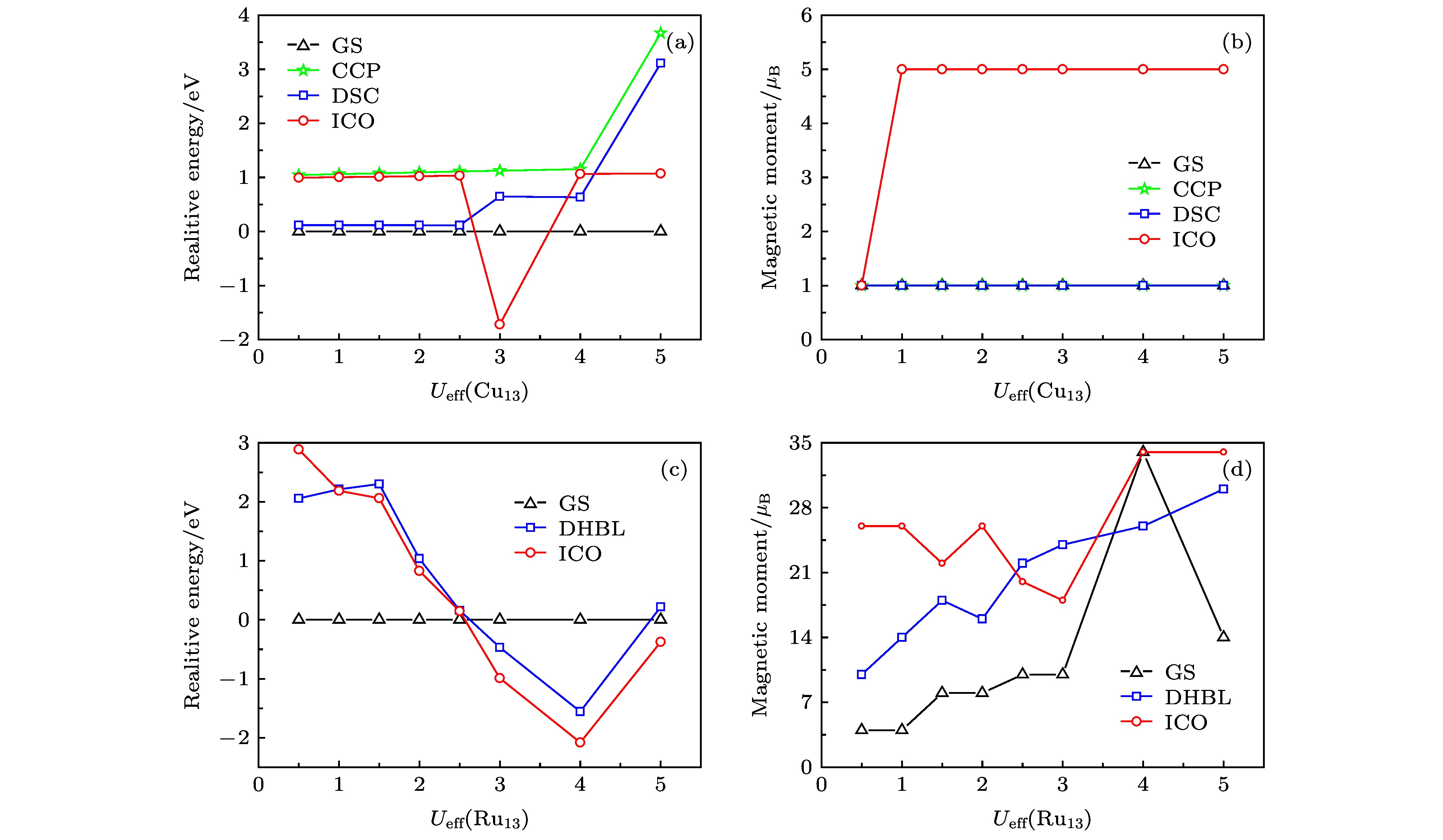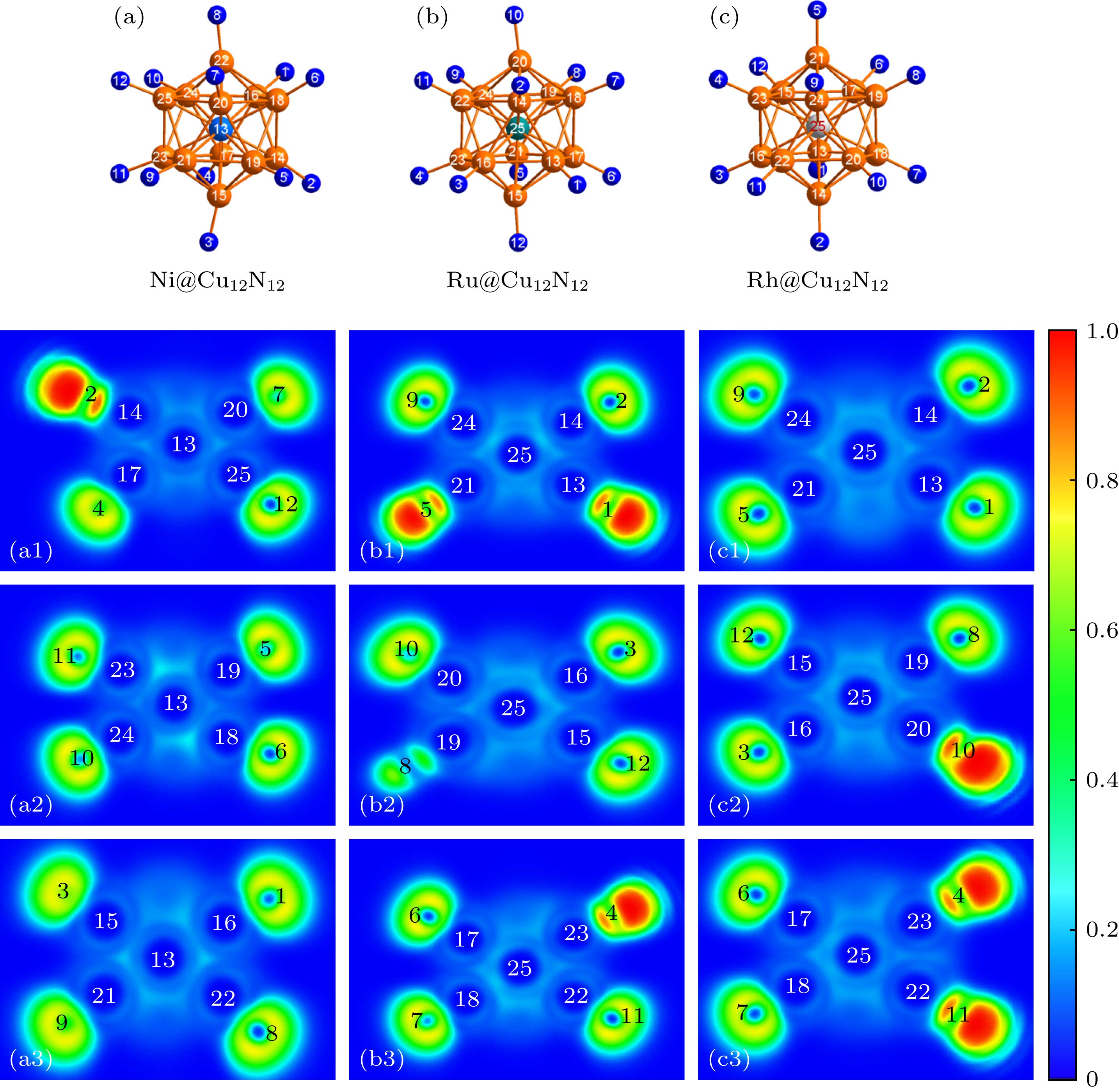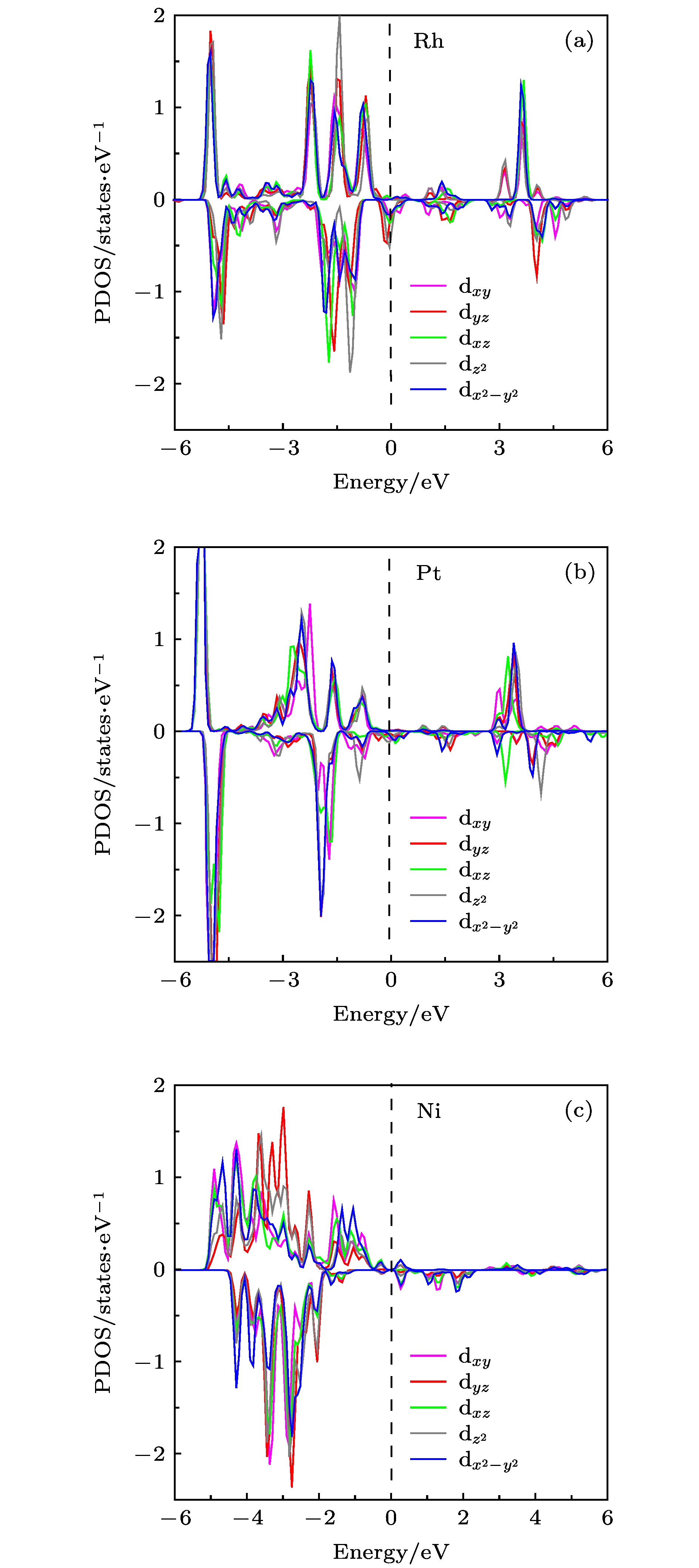-
采用密度泛函理论下的广义梯度近似方法对团簇TM@Cu12N12 (TM = Mn,, Fe, Co, Ni, Cu, Ru, Rh, Pd, Ir, Pt)的结构稳定性、磁性及磁各向异性能进行了系统的理论研究. 发现由于TM—Cu 和 Cu—N键的出现, 不同过渡金属原子(TM)掺杂二十面体Cu13N12 (ICO)团簇的中心原子可以有效提高TM@Cu12N12的稳定性; N原子的加入使Cu团簇的磁性显著提高, 且不同的TM掺杂有效改善了Cu团簇内部的磁性环境; 3d原子的掺杂使团簇的磁性得到进一步提升, 4d, 5d原子的掺杂虽对提高团簇轨道磁矩无明显效果, 但Rh和Pt原子的掺入使其磁各向异性能显著增大, 提高了团簇的磁稳定性. 结果表明对TM@Cu12N12的掺杂改性基本可以达到磁性调控目的.The stability of structure, spin, orbital magnetic moment and magnetic anisotropy energy of TM@Cu12N12 (TM = Mn, Fe, Co, Ni, Cu, Ru, Rh, Pd, Ir, Pt) are systematically investigated within the framework of the generalized gradient approximation with on-site coulomb repulsion density-functional theory (DFT-GGA+U). In the orbital moment and magnetic anisotropy energy (MAE) computation procedure, the spin-orbit coupling is considered and implemented. In this article, we mainly focus on the structure stability and tunable magnetism of the TM atom (Mn, Fe, Co, Ni, Cu, Ru, Rh, Pd, Ir, Pt) substituting the centre atom of icosahedron (ICO) Cu13N12 cluster, finally disclose the physics origin of the structure stability, change magnetism and larger MAE. The results show that the different TM atom doping makes the ICO structure of Cu13N12 cluster appears a tiny deformation. The stabilities of the clusters are evidently enhanced due to the formation of Cu—N and Cu—TM bond. In addition, the N-capped clusters more prefer to present a larger magnetic moment than the pure Cu13 one. The magnetic environment of clusters is improved to varying degrees by doping different TM (TM = Mn, Fe, Co, Ni, Cu, Ru, Rh, Pd, Ir, Pt) atoms, which endows TM@Cu12N12 clusters with various magnetic properties. For instance, the doping of 3d atoms further enhances the spin magnetic moment of the clusters, the Mn, Fe and Co atoms replacing the centre atom of the ICO Cu13N12 generate 35, 32 and 33 giant moments, respectively. In light of the doping of 4d, 5d transition metal atoms, the orbital moments of the TM@Cu12N12 clusters do not increase evidently, but the MAE remarkably strengthens for the doping of Rh and Pt atoms, the MAE values reach to 15.34 meV/atom and 6.76 meV/atom for Rh@Cu12N12 and Pt@Cu12N12, respectively. The tunable magnetism of TM@Cu12N12 cluster provides promising applications in spintronics.
-
Keywords:
- density functional theory /
- geometries /
- magnetism /
- magnetic anisotropy energy
[1] Ohno H 1998 Science 281 951
 Google Scholar
Google Scholar
[2] 王凯, 谢泉, 范梦慧 2017 磁性材料及器件 48 58
 Google Scholar
Google Scholar
Wang K, Xie Q, Fan M H 2017 J. Magn. Mater. Devices 48 58
 Google Scholar
Google Scholar
[3] Baik J M, Jang H W, Kim J K, Lee J L 2003 Appl. Phys. Lett. 82 583
 Google Scholar
Google Scholar
[4] Dhar S, Brandt O, Trampert A, Däweritz L, Friedland K J, Ploog K H, Keller J, Beschoten B, Güntherodt G 2003 Appl. Phys. Lett. 82 2077
 Google Scholar
Google Scholar
[5] Polyakov A Y, Smirnov N B, Govorkov A V, Pashkova N V, Shlensky A A, Pearton S J, Overberg M E, Abernathy C R, Zavada J M, Wilson R G 2003 J. Appl. Phys. 93 5388
 Google Scholar
Google Scholar
[6] Liu H X, Wu S Y, Singh R K, Gu L, Smith D J, Newman N, Dilley N R, Montes L, Simmonds M B 2004 Appl. Phys. Lett. 85 4076
 Google Scholar
Google Scholar
[7] Cui X Y, Medvedeva J E, Delley B, Freeman A J, Newman N, Stampfl C 2005 Phys. Rev. Lett. 95 256404
 Google Scholar
Google Scholar
[8] Buchholz D B, Chang R P H, Song J Y, Ketterson J B 2005 Appl. Phys. Lett. 87 082504
 Google Scholar
Google Scholar
[9] Lee J H, Choi I H, Shin S, Lee S, Lee J, Whang C, Lee S C, Lee K R, Baek J H, Chae K H, Song J 2007 Appl. Phys. Lett. 90 032504
 Google Scholar
Google Scholar
[10] Seong H K, Kim J Y, Kim J J, Lee S C, Kim S R, Kim U, Park T E, Choi H J 2007 Nano Lett. 7 3366
 Google Scholar
Google Scholar
[11] Wu R Q, Peng G W, Liu L, Feng Y P, Huang Z G, Wu Q Y 2006 Appl. Phys. Lett. 89 062505
 Google Scholar
Google Scholar
[12] Ling W, Dong D, Shi-Jian W, Zheng-Quan Z 2015 J. Phys. Chem. Solids 76 10
 Google Scholar
Google Scholar
[13] Yuan J, Yang B, Li G, Si Y, Wang S, Zhang S, Chen H 2015 Comput. Mater. Sci. 102 213
 Google Scholar
Google Scholar
[14] Chaves A S, Rondina G G, Piotrowski M J, Da Silva J L F 2015 Comput. Mater. Sci. 98 278
 Google Scholar
Google Scholar
[15] Datta S, Banerjee R, Mookerjee A 2015 J. Chem. Phys. 142 024309
 Google Scholar
Google Scholar
[16] Yin M, Bai X, Lü J, Wu H S 2019 J. Magn. Magn. Mater. 481 203
 Google Scholar
Google Scholar
[17] Yuan H K, Chen H, Kuang A L, Tian C L, Wang J Z 2013 J. Chem. Phys. 139 034314
 Google Scholar
Google Scholar
[18] Bai X, Lü J, Zhang F Q, Jia J F, Wu H S 2018 J. Magn. Magn. Mater. 451 360
 Google Scholar
Google Scholar
[19] Piotrowski M J, Piquini P, Da Silva J L F 2010 Phys. Rev. B 81 155446
 Google Scholar
Google Scholar
[20] Chaves A S, Rondina G G, Piotrowski M J, Tereshchuk P, Da Silva J L 2014 J. Phys. Chem. A 118 10813
 Google Scholar
Google Scholar
[21] Hakkinen H, Moseler M, Landman U 2002 Phys. Rev. Lett. 89 033401
 Google Scholar
Google Scholar
[22] Datta S, Saha-Dasgupta T 2013 J. Phys.: Condens. Matter 25 225302
 Google Scholar
Google Scholar
[23] Becke A D, Edgecombe K E 1990 J. Chem. Phys. 92 5397
 Google Scholar
Google Scholar
[24] Zhang S, Wang Q, Kawazoe Y, Jena P 2013 J. Am. Chem. Soc. 135 18216
 Google Scholar
Google Scholar
[25] 金安定, 刘淑薇, 吴勇 1999 高等无机化学简明教程(南京: 南京师范大学出版社)第305页
Jin A D, Liu S W, Wu Y 1999 Concise Course on Advanced Inorganic Chemistry (Nanjing: Nanjing Normal University Press) p305 (in Chinese)
[26] Wang D S, Wu R, Freeman A J 1993 Phys. Rev. B 47 14932
 Google Scholar
Google Scholar
[27] Wang P, Jiang X, Hu J, Huang X M, Zhao J J, Ahuja R 2017 J. Phys.: Condens. Matter 29 435802
 Google Scholar
Google Scholar
[28] Hu J, Wang P, Zhao J J, Wu R Q 2018 Advances in Physics: X. 3 1432415
 Google Scholar
Google Scholar
-
表 1 Cu13以及TM@Cu12N12团簇的结合能(Eb)和杂化指数(Hkl)
Table 1. The binding energies and hybridization index of Cu13 and TM@Cu12N12 clusters.
Clusters Binding energy
Eb/eV·atom–1Hybridization index hsp hsd hpd Htol Cu13 1.50 0.06 0.21 0.14 0.40 Mn@Cu12N12 1.58 0.09 0.20 0.15 0.43 Fe@Cu12N12 1.58 0.12 0.21 0.17 0.50 Co@Cu12N12 1.62 0.10 0.19 0.16 0.45 Ni@Cu12N12 1.63 0.17 0.27 0.24 0.68 Cu13N12 1.56 0.12 0.20 0.19 0.51 Ru@Cu12N12 1.64 0.25 0.29 0.26 0.80 Rh@Cu12N12 1.67 0.21 0.28 0.25 0.74 Pd@Cu12N12 1.60 0.16 0.25 0.23 0.65 Ir@Cu12N12 1.70 0.22 0.30 0.23 0.75 Pt@Cu12N12 1.69 0.21 0.26 0.23 0.70 表 2 TM@Cu12N12团簇的原子平均Bader电荷分布和原子平均局域磁矩
Table 2. The excess Bader charge and local magnetic moments of atoms in TM@Cu12N12 clusters.
Cluters Bader charge/e Local magnetic moments/μB TM Cu N TM Cu N Mn@Cu12N12 0.29 0.25 –0.27 3.49 0.39 1.50 Fe@Cu12N12 0.09 0.27 –0.28 2.73 0.31 1.44 Co@Cu12N12 –0.15 0.29 –0.28 1.69 0.39 1.49 Ni@Cu12N12 –0.33 0.31 –0.28 0.10 0.27 1.40 Cu13N12 –0.19 0.30 –0.28 0.05 0.29 1.43 Ru@Cu12N12 –0.59 0.35 –0.30 0.29 0.27 1.33 Rh@Cu12N12 –0.64 0.35 –0.30 0.09 0.31 1.42 Pd@Cu12N12 –0.62 0.33 –0.28 0.03 0.29 1.41 Ir@Cu12N12 –0.94 0.37 –0.29 0.14 0.30 1.34 Pt@Cu12N12 –0.92 0.36 –0.29 0.10 0.31 1.41 -
[1] Ohno H 1998 Science 281 951
 Google Scholar
Google Scholar
[2] 王凯, 谢泉, 范梦慧 2017 磁性材料及器件 48 58
 Google Scholar
Google Scholar
Wang K, Xie Q, Fan M H 2017 J. Magn. Mater. Devices 48 58
 Google Scholar
Google Scholar
[3] Baik J M, Jang H W, Kim J K, Lee J L 2003 Appl. Phys. Lett. 82 583
 Google Scholar
Google Scholar
[4] Dhar S, Brandt O, Trampert A, Däweritz L, Friedland K J, Ploog K H, Keller J, Beschoten B, Güntherodt G 2003 Appl. Phys. Lett. 82 2077
 Google Scholar
Google Scholar
[5] Polyakov A Y, Smirnov N B, Govorkov A V, Pashkova N V, Shlensky A A, Pearton S J, Overberg M E, Abernathy C R, Zavada J M, Wilson R G 2003 J. Appl. Phys. 93 5388
 Google Scholar
Google Scholar
[6] Liu H X, Wu S Y, Singh R K, Gu L, Smith D J, Newman N, Dilley N R, Montes L, Simmonds M B 2004 Appl. Phys. Lett. 85 4076
 Google Scholar
Google Scholar
[7] Cui X Y, Medvedeva J E, Delley B, Freeman A J, Newman N, Stampfl C 2005 Phys. Rev. Lett. 95 256404
 Google Scholar
Google Scholar
[8] Buchholz D B, Chang R P H, Song J Y, Ketterson J B 2005 Appl. Phys. Lett. 87 082504
 Google Scholar
Google Scholar
[9] Lee J H, Choi I H, Shin S, Lee S, Lee J, Whang C, Lee S C, Lee K R, Baek J H, Chae K H, Song J 2007 Appl. Phys. Lett. 90 032504
 Google Scholar
Google Scholar
[10] Seong H K, Kim J Y, Kim J J, Lee S C, Kim S R, Kim U, Park T E, Choi H J 2007 Nano Lett. 7 3366
 Google Scholar
Google Scholar
[11] Wu R Q, Peng G W, Liu L, Feng Y P, Huang Z G, Wu Q Y 2006 Appl. Phys. Lett. 89 062505
 Google Scholar
Google Scholar
[12] Ling W, Dong D, Shi-Jian W, Zheng-Quan Z 2015 J. Phys. Chem. Solids 76 10
 Google Scholar
Google Scholar
[13] Yuan J, Yang B, Li G, Si Y, Wang S, Zhang S, Chen H 2015 Comput. Mater. Sci. 102 213
 Google Scholar
Google Scholar
[14] Chaves A S, Rondina G G, Piotrowski M J, Da Silva J L F 2015 Comput. Mater. Sci. 98 278
 Google Scholar
Google Scholar
[15] Datta S, Banerjee R, Mookerjee A 2015 J. Chem. Phys. 142 024309
 Google Scholar
Google Scholar
[16] Yin M, Bai X, Lü J, Wu H S 2019 J. Magn. Magn. Mater. 481 203
 Google Scholar
Google Scholar
[17] Yuan H K, Chen H, Kuang A L, Tian C L, Wang J Z 2013 J. Chem. Phys. 139 034314
 Google Scholar
Google Scholar
[18] Bai X, Lü J, Zhang F Q, Jia J F, Wu H S 2018 J. Magn. Magn. Mater. 451 360
 Google Scholar
Google Scholar
[19] Piotrowski M J, Piquini P, Da Silva J L F 2010 Phys. Rev. B 81 155446
 Google Scholar
Google Scholar
[20] Chaves A S, Rondina G G, Piotrowski M J, Tereshchuk P, Da Silva J L 2014 J. Phys. Chem. A 118 10813
 Google Scholar
Google Scholar
[21] Hakkinen H, Moseler M, Landman U 2002 Phys. Rev. Lett. 89 033401
 Google Scholar
Google Scholar
[22] Datta S, Saha-Dasgupta T 2013 J. Phys.: Condens. Matter 25 225302
 Google Scholar
Google Scholar
[23] Becke A D, Edgecombe K E 1990 J. Chem. Phys. 92 5397
 Google Scholar
Google Scholar
[24] Zhang S, Wang Q, Kawazoe Y, Jena P 2013 J. Am. Chem. Soc. 135 18216
 Google Scholar
Google Scholar
[25] 金安定, 刘淑薇, 吴勇 1999 高等无机化学简明教程(南京: 南京师范大学出版社)第305页
Jin A D, Liu S W, Wu Y 1999 Concise Course on Advanced Inorganic Chemistry (Nanjing: Nanjing Normal University Press) p305 (in Chinese)
[26] Wang D S, Wu R, Freeman A J 1993 Phys. Rev. B 47 14932
 Google Scholar
Google Scholar
[27] Wang P, Jiang X, Hu J, Huang X M, Zhao J J, Ahuja R 2017 J. Phys.: Condens. Matter 29 435802
 Google Scholar
Google Scholar
[28] Hu J, Wang P, Zhao J J, Wu R Q 2018 Advances in Physics: X. 3 1432415
 Google Scholar
Google Scholar
计量
- 文章访问数: 14050
- PDF下载量: 113
- 被引次数: 0
















 下载:
下载:










